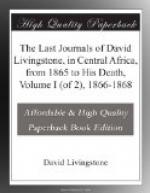1st August, 1867.—Hamees sends off men to trade at Chiwere’s. Zikwe is the name for locust here. Nsige or Zige and Pansi the Suaheli names.
A perforated stone had been placed on one of the poles which form the gateway into this stockade, it is oblong, seven or eight inches long by four broad, and bevelled off on one side and the diameter of the hole in the middle is about an inch and a half: it shows evidence of the boring process in rings. It is of hard porphyry and of a pinkish hue, and resembles somewhat a weight for a digging stick I saw in 1841 in the hands of a Bushwoman: I saw one at a gateway near Kasonso’s. The people know nothing of its use except as a charm to keep away evil from the village.
2nd August, 1867.—Chronometer A. stopped to-day without any apparent cause except the earthquake.
It is probably malaria which causes that constant singing in the ears ever since my illness at Lake Liemba.
3rd August, 1867.—We expect a message from Nsama every day, the new moon having appeared on the first of this month, and he was to send after its appearance.
5th August, 1867.—Men came yesterday with the message that Hamees must wait a little longer, as Nsama had not yet got all the ivory and the goods which were stolen: they remained over yesterday. The headman, Katala, says that Lunda is eight days from Nsama or Moero, and in going we cross a large river called Movue, which flows into Luapula; another river called Mokobwa comes from the south-east into Moero. Itawa is the name of Nsama’s country and people.
A day distant from Nsama’s place there is a hot fountain called “Paka pezhia,” and around it the earth shakes at times: it is possible that the earthquake we felt here may be connected with this same centre of motion.
6th August, 1867.—The weather is becoming milder. An increase of cold was caused by the wind coming from the south. We have good accounts of the Wasongo from all the Arabs, their houses built for cattle are flat-roofed and enormously large; one, they say, is a quarter of a mile long. Merere the chief has his dwelling-house within it: milk, butter, cheese, are in enormous quantities; the tribe, too, is very large. I fear that they may be spoiled by the Arab underlings.
7th August, 1867.—Some of my people went down to Karambo and were detained by the chief, who said “I won’t let you English go away and leave me in trouble with these Arabs.”
A slave had been given in charge to a man here and escaped, the Arabs hereupon went to Karambo and demanded payment from the chief there; he offered clothing, but they refused it, and would have a man; he then offered a man, but this man having two children they demanded all three. They bully as much as they please by their fire-arms. After being spoken to by my people the Arabs came away. The chief begged that I would come and visit him once more, for only one day, but it is impossible, for we expect to move directly. I sent the information to Hamees, who replied that they had got a clue to the man who was wiling away their slaves from them. My people saw others of the low squad which always accompanies the better-informed Arabs bullying the people of another village, and taking fowls and food without payment. Slavery makes a bad neighbourhood!




